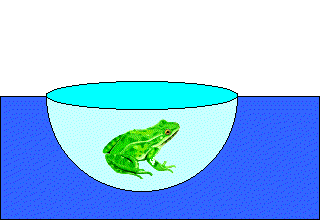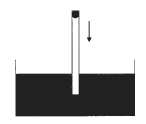
Near the surface of a planet like Earth but with no atmosphere a small solid
sphere of mass m and density ρ = ½ρwater is held near the center of a
large box filled with water on top of a high tower. The box and the sphere are
released simultaneously.
(a) What are the force of gravity Fg acting on the sphere, the net force
Fnet acting on the sphere, and the acceleration
a of
the sphere?
(b) If only the sphere is released, but the box is held fixed, what, initially,
are the force of gravity Fg acting on the sphere, the net force
Fnet
acting on the sphere, and the acceleration a of the sphere?
(c) In case (b), if we set Fg = m*a, what is the
effective mass m* of the sphere?
Solution:
A Styrofoam slab has a thickness h and a density ρobject. What is the area of the slab, if it floats with its top surface just awash in fresh water when a swimmer of mass m is on top?
Solution:
Problem:
A frog in a hemispherical pod finds that he just floats without sinking into a sea of blue-green ooze with density 1.35 g/cm3. If the pod has radius 6 cm and negligible mass, what is the mass of the frog?

Solution:
A beaker of mass 1 kg containing 2 kg of water rests on a scale. A 2 kg
block of aluminum (specific gravity of 2.7) is suspended from a spring scale and
is submerged in the water.
(a) What does the upper spring scale read
for the weight of the aluminum block?
(b) What does the lower scale
read for the weight of the whole system?
Solution:
A polar bear partially supports herself by pulling part of her body out of the water onto a rectangular slab of ice of volume 10 m3. The ice sinks down so that only half of what was once exposed now is exposed, and the bear has 60% of her volume (and weight) out of the water. Assume that the bear and the water have mass density 1 g/cm3 and ice has mass density 0.9 g/cm3. Estimate the bear's mass.
Solution:
With the bear:
B = (1 - f/2)(10 m3)*(1000 kg/m3)*g
= (9500 kg)*g.
W = (9000 kg)*g + 0.6*mbear*g.
0.6*mbear
= 500 kg, mbear = 833 kg.
A thin vertical uniform wooden rod is pivoted at the top and immersed in water as shown.

The pivot point is slowly lowered. At a certain moment the rod begins to deflect from the vertical. What fraction of the rod is still in the water at that moment if the density of the rod is one-half of the density of water?
Solution:

Let the rod have length L and cross sectional area A
(√A << L), and let aL be the length of the section of the rod in the water.
Assume the rod is displaced by a small angle θ. In the small angle
approximation, the torque about the pivot point is
τ = mgLθ/2 - B(1 -
a/2)Lθ = ½ρwatergAL2θ/2 - ρwatergaAL2(1
- a/2)θ, counterclockwise.
As long as τ is positive we have a restoring
force and a stable equilibrium. When τ is negative we have an unstable
equilibrium and the rod will deflect from the vertical.
At the moment the
rod begins to deflect from the vertical τ = 0.
½ρwatergAL2θ/2
- ρwatergaAL2(1 - a/2)θ = 0, ½ - a(2 - a) = 0, a2
- 2a + ½ = 0,
a = (1 - √½).
When the fraction of the rod under
water is (1 - √½) ≈ 0.3, the rod begins to deflect from the vertical.